July 3 through 12,
2015
To view clips cited in the text,
see the
“Kilimanjaro Machame Route”
video:
My Video Channel
Background
July is technically the middle of Winter south of the equator,
but Kilimanjaro is located at just over 3°
south latitude so there is little difference in seasonal temperatures.
What is more important is rainy versus dry,
and July is the start of the dry season,
making it one of the more desirable times to climb.
It is a stretch to refer to this as a climb,
as there is no technical skill required.
In fact,
it is unusual to encounter more than a few inches of snow on the ground
during the dry season.
It is more accurate to refer to it as a very strenuous hike.
The players:
Gary
(me),
daughter Kendal
(29 years),
and son Arthur
(27½ years).
Kendal and Arthur were in good health,
while I was in treatment for chronic back pain.
Fortunately,
the best remedy for the pain was to take long walks.
Though I was usually the oldest person in sight
(at 68 years, 10 months),
the
oldest person to climb Kilimanjaro
was aged 86 years,
267 days.
She summited 3 months after us.
Perhaps I will do it again in 2035 and set a new record ;-).
We all began conditioning months before the climb.
Arthur and I live at over 5,000' thus had a head start on
acclimatization;
our home in Bridger Canyon is already at
82% of sea level pressure.
Kendal lives at sea level,
but she trained there and spent a week here
(at 5,400’, 1,646 meters)
immediately before flying to Africa.
While she was here she kept up with me on ambitious
conditioning hikes
in the Bridger Mountains.
July 2 and 3:
Getting There
We departed Bozeman at 6am on July 2 and arrived at
Kilimanjaro Airport
in Tanzania late on July 3,
having pampered ourselves with business class flights via Minneapolis
and Amsterdam.
We were met by a
Kilele Afrika
representative
(Richard)
and transported to
Kaliwa Lodge.
The lodge is located at approximately 1,300 meters
(4265')
elevation near the village of Machame and is convenient to the Machame
Gate.
July 4:
Day 0 —
Gear Check and Briefing
In the morning guide Nicholas visited for our gear check and briefing.
All was well,
except I had wound up giving my medium weight gloves to Kendal or Arthur
and forgot to replace them;
thus,
I had to rent gloves.
To save space and weight in our travel luggage we had rented
sleeping bags,
mats and liners as well as duffel bags.
We each received a card entitling us to one emergency helicopter
evacuation in case of medical emergency and were told to keep it on us
at all times.

After the gear check we decided to go for a hike to the nearby Weru Weru
River.
Immediately upon exiting the lodge compound we were surrounded by a
group of children who were intent on showing us around.
In spite of language difficulties they understood we wanted to go to the
river and offered to show us their favorite spot
(0:38 in the video).
As we hiked along they showed us the banana,
coffee and avocado plants grown by the local farmers.
They showed us how the things they found around them became toys:
vines were skip-ropes,
leaves made gliders and kazoos,
and flat stones were for skipping across the river.
One boy was quite expert at skipping stones and easily got 3 times
as many skips as our best efforts.
We finally arrived at a
“swimming hole”
where Arthur joined one of the boys in the river.
We were close to the mountain so the river was quite cold.
On the way back to Kaliwa Lodge the children insisted on showing us
their school.
It was several buildings with simple classrooms.
They were very proud of recent improvements to the facility.
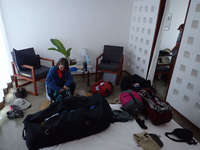
After lunch we packed our duffel bags and day packs in preparation for
the next day.
We were each 2-3 kg under the allotted 15 kg load the porters will carry
for us.
Kendal and I put empty disposable water bottles into our duffels for a
later demonstration of what the air is like at the summit.
Kilimanjaro Park does not allow disposables on the mountain in an
attempt to keep the mountain clean.
But in this case we were resolved to smuggle it in and
“pack it out.”
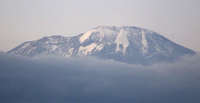
In the evening after dinner we walked down to the patio overlooking the
river to watch monkeys playing in the trees.
As evening brought cooler temperatures the clouds opened enough to
reveal impressive
(and imposing)
views of Kilimanjaro.
Our route would take us from left to right below the glaciers and up
the ridge on the right skyline.
July 5:
Day 1 —
Machame Gate
(5,400')
to Machame Camp
(9,400')

We were picked up from Kaliwa Lodge at 9am for the short drive to
Machame Gate.
The day started out misty;
the 60 degree weather was a welcome break from the heat wave we had left
in Bozeman.
While we waited at the Machame Gate for the guides to complete filling
out necessary paperwork and organize the support personnel,
someone in another party exclaimed
“Look at the monkeys!”
Being experienced in these matters,
we immediately checked to make sure we had left nothing laying around
for monkeys to steal.
People in other parties reacted by grabbing their cameras.
Sure enough,
one person had a bag of medications stolen and another lost their packed
lunch.
The medications were retrieved by a guide,
but the lunch was history.
We learned there would be a total of 22 support personnel for the three
of us.
We had booked a better than average private tour and,
based on the usual ratio of porters to hikers,
we had expected a total of 17 personnel.
However,
the trip was originally booked for 4 hikers;
one had dropped out and no adjustment to the staff had been made.
There were two guides
(Renatus and Nicholas),
a cook,
a waiter
(Bima),
a toilet porter and 17 porters.
The park has a number of regulations regarding the number of support
personnel required for a climbing party;
this is a significant source of revenue for the area.
Locals queue up outside the gate hoping to get a job and we heard that
some companies take advantage of this by paying them low
(or even no)
wages;
these
“pick-up”
porters are rumored to pester climbers for tips and pilfer gear.
The porters for our group were Kilele Afrika regulars and therefore well
paid and trustworthy.
The porter's loads are weighed and adjusted to be 25kg
(approximately 55 pounds).
They carry our allotment of 15kg of personal gear each
(mostly clothing, sleeping gear and medications)
plus tents,
food,
cooking gear,
fuel,
and their own personal gear.
For each camp they collect and carry significant amounts of water
for washing,
cooking and drinking.

The first day's hike was easy for us as it involved altitudes very
similar to what we acclimatized to in our training hikes around Bozeman
in the Bridger Mountains.
At lunch time we arrived at a small clearing to find a table and
chairs set with a nice meal of fruits,
vegetables,
meats and a variety of drinks served with real plates,
cups and silverware.
This was a daily ritual:
the porters raced ahead to get lunch set up,
then packed up as soon as we finished to race ahead and set up camp and
dinner.
Meanwhile,
we were encouraged to go
polepole
(slowly);
while this was intended to help us acclimatize,
it gave the porters a little more time to do their job.
Near the end of the day's hike,
the guides commented we appeared to be
“summit material”
because we had kept up a continual banter of questions,
jokes and family matters while walking.
Apparently,
those who don't have enough breath left to talk at this early stage are
poor candidates for the summit.

There are toilets placed periodically along the trail,
but they are generally filthy and even rotting through,
giving real meaning to the admonition
“don't fall in.”
In addition,
they are
long drop squat toilets,
making them awkward for those of us unaccustomed to them.
We learned the code phrase
“I'm going to see the monkeys”
meant one was going to find a discrete place to relieve oneself.
For the first two days this usually meant a couple of steps off the
trail,
but as we ascended to the desert-like areas it meant finding a large
enough rock far enough from the trail to ensure privacy.
While in camp,
we had a small tent with a camp toilet
(about as large as a medium sized ice chest)
to serve the three of us.
The camp toilet was emptied every day,
presumably in an appropriate place.
We appreciated the private toilet very much and thought the extra pay
the toilet porter gets was well worth it.
Note:
There is an effort underway to improve the toilet facilities at the
camps,
but even there we appreciated having a private toilet handy to our
tents.

Most of the day was spent hiking through jungle rain forest canopy,
but as we approached Machame Camp the vegetation began to transition to
the more open Moorland environment;
see
here
for a description of climate zones on the mountain.
On arrival we signed in with the ranger and surveyed a large tent city
populated by all the climbers and
“staff”
headed up the mountain.
We quickly located our subdivision of the tent city by looking for our
distinctive dining tent.
Our tents were set up and the dining tent was ready for
“afternoon tea”
with popcorn,
cookies and hot drinks for us.
Dinner was served after we had a chance to relax and organize our
sleeping arrangements.
This was Kendal's birthday and the porters gathered to sing
“Happy Birthday”
during dessert.
People from nearby tents joined in.
Afterward we were treated to what must be the Swahili version of a
birthday song
(see 2:10 to 4:00 in the video for the celebration).
It had started raining when we arrived at camp and rained until 10pm,
well after we had tucked in for the night.
After it cleared,
night-time trips to the toilet tent were rewarded with magnificent views
of the constellations of the southern hemisphere.
Since we were already well acclimatized to the initial altitudes,
I waited until this night to start my 125mg evening and morning doses of
Diamox
and continued taking them until the evening before climbing to the
summit.
While I think the Diamox helped with acclimatization,
it does have the unwelcome side-effect of causing one to pee a lot.
It can also cause tingling sensations in one's extremities;
I did notice tingling in my thumbs.
July 6:
Day 2 —
Machame Camp
(9,400')
to Shira Camp
(12,500')

The morning ritual is to be awakened at sunrise with a cup of tea or
coffee in bed.
We are each given a basin of warm water to wash up before going to
breakfast in the dining tent ½
hour later.
After breakfast we pack our things into our duffels for the porters to
carry or into our day packs for ourselves.
We are given 3 liters of boiled water,
to which we add purification tablets to make sure it is safe.
It probably was safe;
we ate plenty of uncooked fruit and vegetables and drank the liquids
served at meals with no problem.
We added flavoring or rehydration salts to some of our water to provide
a little variety.
The morning was clear and there were beautiful views of the mountain.
The tents were coated in frost;
though it was above freezing,
it was cold enough for evaporation of the dew to cause frost to form.

This was a fairly short day of hiking.
The Moorland ecology became thinner as we began the transition to an
Alpine Desert environment.
During the hike we ascended to over 13,000' before descending to camp.
The clouds lurking below began to rise as the day warmed and it was
raining by the time we arrived in camp for a late lunch.
During lunch it began to rain in earnest.
We cancelled the usual
“conditioning hike”
to the
Shira Caves.
The guides had encouraged me to eat more than I should have at lunch and
I soon felt ill with acid indigestion and reflux.
I took two acid reducer pills and retired without dinner.
The night before my back had bothered me;
this night I slept on my back with my day pack under my knees and found
it made a big difference in my comfort.
There was probably an element of jet lag that caught up with me this day
as well.
Kendal and Arthur claimed the evening's meal was the best of the trip.
July 7:
Day 3 —
Shira Camp
(12,500')
to Lava Tower
(15,300')
to Barranco Camp
(13,000')
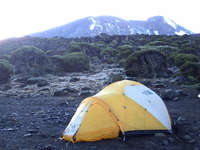
I awoke feeling fine.
The tents were again frost covered;
this time it probably did get below freezing.
This day is a long hike with a lot of elevation gain and loss.
Since I had complained of back pain the day before,
Nicholas offered to carry my day pack,
but I was feeling fine and walking makes my back feel better.
Besides,
I attached a certain amount of pride in being able to at least carry a
day pack.
So I declined.
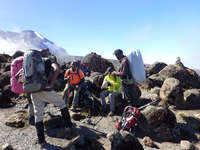
After hiking a short way it became apparent Arthur was not feeling well.
We took a rest break,
then Nicholas tucked Arthur's pack under his arm and we continued up.
I was very concerned with Arthur's ability to continue and considering
the possibility he would have to ditch the climb and go down before we
reached the day's high point at Lava Tower.
Would Kendal and I continue on in that case?
I positioned myself behind Arthur to monitor his progress.
His feet were dragging and on a couple of occasions I moved to break a
possible fall as he teetered along.
But he managed to stay upright.
For the next 2-3 hours we made good time in spite of Arthur's condition,
going
“polepole”
of necessity.
By the time we were nearing the high point at Lava Tower,
Arthur started feeling much better.
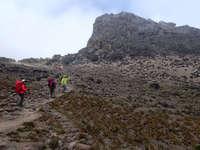
At Lava Tower,
the dining tent and toilet tent were set up for our lunch break.
Arthur was well enough to eat a good lunch.
Meanwhile,
I had resolved to eat only as much as I felt comfortable with.
It was perhaps not enough to sustain me,
but I had enough built-in reserves to tide me over for the trip.
This was the highest any of us had ever been and we were all feeling
well,
so our prospects as a team were much improved from the morning.

As we descended into the valley to the Barranco Camp,
the ecology made a transition from the Alpine desert of our high point
to the unique Moorland ecology of the valley.
As we descended the clouds moved in and it began to rain in earnest.
I had neglected to pack my rain pants in my day pack so my pants and
long underwear got soaked.
I did manage to keep my socks and boots relatively dry.
Even with all their rain gear,
Kendal and Arthur had wet clothing.
We arrived at a wet,
muddy camp.
The insides of the tents were wet,
the sleeping mats had wet spots and there were wet spots inside my
duffel.
I changed into dry clothing and repacked my duffel to try and keep as
much of my clothing dry as possible.
Muddy boots were stashed outside the tent under the rain fly.
We handed our wettest clothing to a porter to hang in the cooking tent
to dry
(they did not dry).
This was definitely the low point of the trip for me;
we each had on our one remaining set of dry clothing and were doubting
our ability to keep dry through the night and the next day.

Things were made better when the cooking staff gave us liter bottles of
hot water to take into our sleeping bags.
In spite of the dampness surrounding us,
I slept warm and well.
The weather cleared during the night,
again rewarding freezing trips to the toilet with marvelous views of the
stars above and the glow of cities under the clouds below.
July 8:
Day 4 —
Barranco Camp
(13,000')
to Karanga Camp
(13,450')
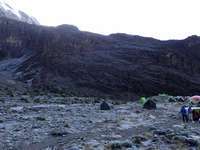
The day dawned clear,
dry and frosty.
We drank our wake-up coffee and piled still damp gear into our duffels
before heading to breakfast.

After breakfast the first order of business was the Barranco Wall.
The wall was more challenging for me than anticipated due to the
irregular pace;
we spent a lot of time allowing porters to pass
(remember: they might be your porters)
punctuated by moves requiring exertion to quickly lift ourselves up
several steep steps.
This made for a
“dash and gasp”
ascent and it was difficult to establish the coordinated rhythm of
movement and breathing needed to ease the challenges of altitude.
However,
after a short rest at the top of the wall,
we were recovered and ready to continue the hike to Karanga.
Sidebar:
Two means of coping with altitude are
pressure breathing and the rest step.
If one can coordinate the rate of breathing with the rate of steps,
it is possible to maintain progress over a long period of time.
At altitude,
slow and steady wins the race.
For relatively smooth trail going
“polepole”
above 13,000',
I was usually walking at two steps per breath
(breathe in while taking a step, breathe out while taking a step)
if the trail was moderate or level,
and at one step per breath
(breathe in and out for each step)
if the trail was steep uphill.
This left plenty of breath for talking.
For people on the 6-day plan,
this day continues on to Barafu Camp for a summit attempt the following
day.
That not only makes for two consecutive strenuous days,
it means one less day to acclimatize.
By taking the 7-day plan,
we had a more leisurely pace traversing the ups and downs of the trail
while our bodies got used to the altitude.
Of course,
the 7-day plan costs a bit more,
but I highly recommend it.
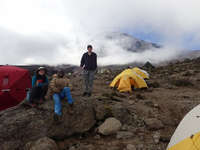
The clouds had moved up to surround us as we climbed the Barranco Wall,
but as we approached Karanga Camp they receded into the valleys.
We arrived at a dry camp in fine weather.
We hung out our wet things to dry in the sun and wind then enjoyed a
lazy afternoon.
Things were looking good again!
After dinner we had our regular guide briefing on what to expect the
next day.
We were told we would not stay at Barafu,
but continue on to a higher camp known as Kosovo
(presumably the person who established it as a high camp was from Kosovo and it reminded him of the bombed-out ruins of home).
No reason was given for this change and I neglected to ask.
It seemed like a good idea to me:
we had plenty of time to go the additional distance,
we would get an additional hour of sleep before the climb to the summit
started and we were having little trouble with the altitude.
Of note were the final words of the briefing:
“As we approach the high camp, you will see people returning from the summit. Do not let that disturb you.”
We retired to our tents with our liter bottles of hot water and
contemplated the possible meanings of the warning.
July 9:
Day 5 —
Karanga Camp
(13,450')
to Kosovo Camp
(15,600')
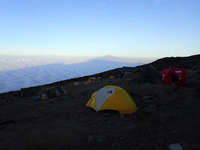
The day dawned clear and frosty.
We were camped on an island called
Kibo
situated in a calm sea of clouds far below us covering everything in
every direction as far as we could see,
with only the peak of
Meru
visible as another island in the distance.
Note:
this is a very different mountain than the
Mount Meru
in India.
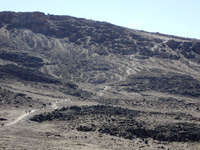
After an easy hike followed by a steep climb to Barafu Camp,
we signed in with the rangers and retired to our dining tent for lunch.
Kendal had a mild headache and Arthur had a headache and bleeding from
the nose membranes.
I had no headaches or nausea but did not have an appetite for any but
the simplest foods such as raw vegetables and vast quantities of
Milo
mixed with water.
Kendal and Arthur managed to eat much more than I did.
My digestive problems continued after getting home,
ruling out problems related to travel.
After consulting two doctors and monitoring my diet,
it was discovered I had late onset
lactose intolerance.
Since Milo contains milk powder,
consuming large quantities of it only made matters worse.
At Barafu and as we continued up to the Kosovo Camp,
the meaning of the previous day's warning became clear.
We saw several people returning from the mountain being supported by two
guides,
a few being supported by one guide,
and many walking like zombies.
One woman was crying and saying she could not see,
probably from not using proper eye wear,
thus contracting
snow blindness
(not a good thing, but it resolves after a couple of days in darkness).
We tried to not let it disturb us.
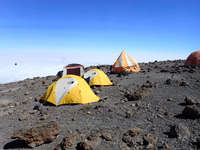
While I relaxed in the tent at Karanga and Kosovo camps I listened to
Kendal and Arthur talking with Renatus's son.
Renatus had brought him along as a porter to earn money for
school as well as learn what life is like for someone without an
education.
He is 18,
speaks excellent English and appears to be quite intelligent.
The Tanzanian school system is different than ours in that it is
necessary to pass exams to go on to the next level.
He was going to be taking the exams to pass on to what appears to correspond
to our first two years of college.
We went to bed early,
cherishing our liter bottles of hot water,
and tried to sleep in preparation for a very hard day ahead.
That night I tried to estimate my resting pulse but did not want to turn
on my headlamp and open up my sleeping bag to look at my watch,
exposing myself to the cold.
I was satisfied to judge it seemed only a little faster than resting at
home.
July 10:
Day 6 —
Kosovo Camp
(15,600')
to Summit
(19,341')
to Mweka Camp
(10,000')

We were awakened at 12am with the usual hot drinks,
got dressed and had a light snack.
We left for the summit at 1am.
It was a moonless night,
so everyone had headlamps to light their way.
Looking up the mountain I saw a stream of lights winding up the mountain
ahead of us.
Many people had started much earlier.
Guides Renatus and Nicholas set a fast pace up the mountain;
we passed many people as we gained altitude on the steep,
irregular trail.
For much of the way we were maintaining a one step per breath pace.
At approximately 18,500'
my back was hurting every time I had to take a long step up with my
right foot.
I began to worry if I continued to the summit I would be spending the
next 5 weeks of our Africa travels with back pain.
Nicholas must have noticed my plight and offered to carry my day pack.
This time I swallowed my pride and accepted.
The lightened load made a big difference.
A short time later,
Kendal turned her pack over to Renatus,
while Arthur continued to carry his own.
I had noted neither guide brought a pack;
perhaps they anticipated the possibility of taking ours.
With my lightened load,
I was proceeding at a rate of two breaths for every step up the very
steep slope.
Near the summit of Everest,
climbers talk of taking four breaths per step;
two breaths per step already seems maddeningly slow.
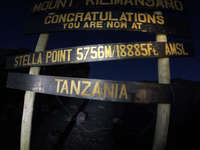
We arrived at Stella Point at 6am.
The eastern horizon was beginning to lighten.
We did not pause at Stella Point,
but continued on around the crater rim toward the summit.

As we passed 19,000'
elevation I paused to take pictures and a video of the imminent
sunrise.
Panning from east to west
(left to right in the picture facing south),
the transition from light to dark was dramatic.
It was a marvelous feeling to be on the boundary between day and night.
Of course,
the video I took does not capture the dramatic transition since the
camera attempted to compensate for the lower light as I panned to the
west
(17:00 in the video).
The crater rim has a much gentler slope and smooth trail so we sped up
the pace a bit;
I was able to maintain two steps per breath most of the way to the summit.
The sun rose when we were ½ way up the crater rim.
We arrived at the summit at 7am.
Gaining over 3,500' in 6 hours at this altitude is a very good pace!
The temperature was -7°C
(20°F)
and there was a strong wind.
Even with hand warmers inside my down mitts my fingertips were tingling,
perhaps from Diamox,
low oxygen and/or low temperature.
I had packed hand warmers around the
CamelBak
inside my pack and had an insulated tube running outside to drink from
it.
In spite of taking care to blow water out of the tube back into the
CamelBak every time I took a drink,
I was starting to detect slush when I drank.
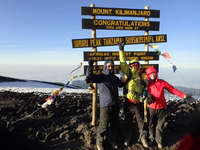
At the summit we quickly took pictures and videos and looked around.
Since Kilimanjaro is a solitary mountain on an immense plain –
the
highest free-standing mountain
on earth –
it may appear one can see the curvature of the earth on the relatively
smooth horizon.
Most high mountains are surrounded by other mountains,
making the horizon irregular and thus making the curvature of the earth
less noticeable.
In this case,
the curvature is undoubtedly due to the camera lens since one
cannot see the curvature
below about 35,000 feet on a clear day with a broad vista.
Kendal and I opened our empty disposable water bottles and closed them
tightly to take home air from Kilimanjaro's summit.
After 15 minutes we began our descent.

Below Stella Point we avoided the steep rock we had come up and headed
to skier's left where there are long slopes of loose pumice scree.
We were able to
plunge step
down at a high rate of speed.
The fine dust we stirred up was terrible;
it was impossible not to breathe it in.
We all suffered from dust in the nose and throat for days afterward.
On the way down,
I got irritated at Renatus because we had not had any real rest breaks
and had not been able to drink much
(Nicholas had my pack with the water, making it inconvenient to get a drink).
We finally took one short break and continued down to the high camp at
Kosovo
(pictured here).
We were told the nominal time for summit and return was 10 hours.
According to my GPS,
when we got to Kosovo our round trip time was 8 hours and 20 minutes.

Back in camp we were supposed to have lunch and rest for a couple of
hours before continuing down to Mweka Camp for the night.
The wind was fierce.
While we collected gear and packed duffels in our tents the toilet tent
was blown away,
hitting Kendal's tent as it flew down the mountain.
The dining tent was blown down;
we were told lunch would be served in our sleeping tents.
Meanwhile,
Arthur started feeling ill,
showing signs of
high altitude pulmonary edema.
It was decided he had to go down immediately.
I started preparing Arthur's and my duffels to descend,
but in the short time it took to prepare I learned Nicholas had already
started down,
carrying Arthur's pack and supporting him by one arm,
thereby making Arthur one of the
“disturbing”
sights for the next day's climbers.
I told Renatus I was going to follow them,
but he could not let me go alone –
there is a rule clients must be accompanied by a guide,
meaning he,
Kendal and I had to leave together.
Kendal was quickly ready to go
(probably looking forward to getting out of the wind)
and Renatus was soon ready.
By this time,
Nicholas and Arthur had at least a 20 to 30 minute head start.
Lunch was ready,
but we left the food for the porters to consume.
Now Renatus was irritated,
perhaps because he could not be supervising the break-up of camp and
would be missing his lunch.
As we descended I suggested to him he would do the same if it was his
son.
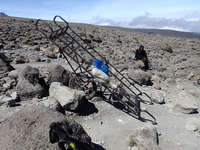
We finally caught up with Nicholas and Arthur at Millennium Camp
(12,500').
Arthur was still feeling out of sorts and needed to go lower,
so we continued down to the site being prepared at Mweka Camp.
Nicholas continued to carry Arthur's pack and support him much of the
way down.
I was keeping up,
but Kendal lagged behind and Renatus stayed with her.
Finally,
two of the porters came back up the trail to take our packs and
accompany us down.
In camp porters helped us remove our boots and handed us hot drinks.
The toilet tent had been found and was damaged but serviceable.
The dinner tent was also damaged but serviceable.
Both were definitely seeing their last day of service.
It was getting close to sundown.
We were all beat and very hungry.
Kendal and I ate dinner while Arthur rested.
My appetite was restored and I had extra helpings,
making up for the lunch we missed as well as the small portions I had
consumed over the past few days.
We headed to bed around 7pm.
Given we were well acclimatized,
being at the 10,000'
elevation of the Mweka Camp should be enough to resolve pulmonary edema,
but it was not a guarantee.
Going to 7,000'
would be a virtual guarantee,
as I
know from experience
and from experts
(there is a reason airliners are pressurized to 8,000' or lower).
As we lay in the tent preparing to sleep,
Arthur said he was feeling neither better nor worse.
I told him if he started feeling worse to let me know and we would
continue down.
I don't think I mentioned what a hassle it would be in the dark,
given we were tired and the trail is still rough going for a couple of
miles.
In addition,
there are no places to stop until the Mweka Gate,
over 4,000'
below.
Fortunately,
his condition improved through the night.
Had it been necessary to take him down we might have used one of the
“stretchers”
pictured here.
In retrospect:
Renatus had pressed us hard getting to the summit,
limited our time at the summit and rushed getting back to high camp.
The rationale is the more time spent at altitude,
the higher the chances of developing one of the various forms of
altitude sickness.
I was not happy with the rush,
but had we not pressed so hard or had taken more or longer breaks,
it is possible the onset of Arthur's symptoms would have come at a less
opportune point in the ascent or descent.
July 11:
Day 7 —
Mweka Camp
(10,000')
to Mweka Gate
(5,400')
Due to the rush evacuating Arthur from Kosovo Camp coupled with our
fatigue there are no pictures from the time we left Kosovo until we were
most of the way down to the Mweka Gate.

We slept a bit later this morning.
Arthur was better,
but still experiencing headaches.
The walk to the gate was relatively easy;
at first the trail was irregular and required care,
but as we descended it turned into a smooth trail and eventually into a
dirt road.
Along the way we caught glimpses of the mountain through gaps in the
rain forest trees.
We saw Colobus monkeys and other wildlife as we descended into the
jungle.
It was a welcome contrast from several days in a bleak environment.
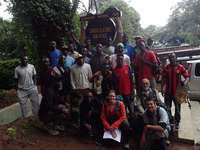
At the gate,
the whole crew gathered for the traditional songs and presentation of
tips
(21:05 in the video).
The tips consisted of a large stack of US currency Kendal and I had
carried to the summit and back.
We were concerned to make sure the tips were shared equitably,
having heard of porters being short changed by sleazy operators.
Kilele Afrika had given us tipping guidelines and told us to give the
money to the guides.
Renatus and Nicholas took the money and counted it in front of the
entire staff,
so it is clear they all had a good idea of what their share would be.
I discreetly slipped a bit extra to Nicholas for his help with Arthur on
days 3 and 6 and for carrying my pack near the summit.
Kendal gave a little extra to Bima for his excellent good humor serving
us meals.
If one gives these extra tips,
one should do it on a very limited basis and not let other staff see as
it undermines the authority of the guides.
The crew did an excellent job and we hope they considered our tip to be
generous.
I gave Nicholas my CamelBak and water bottle since his had fallen out of
my pack somewhere near the summit.
Finally,
we signed out with the rangers and got our diplomas indicating our
successful climb to the summit.
We headed to the hotel with Renatus,
where we turned over things we no longer needed and did not want to
carry on the remainder of our trip.
Included were climbing boots,
fleece jacket,
socks,
gaitors,
water bottles,
nylon pants,
down mitts,
Diamox,
water purification tablets,
et cetera.
I am sure he and Nicholas will find the gear useful.
Even though much of the clothing will fit neither of them,
it will undoubtedly find homes with someone who needs it.
The next big event of the day was to be a hot shower at
Sal Salinero Hotel
in Moshi.
We arrived to find the power out and with no power there is no hot water
and little water pressure.
Kendal and Arthur managed to shower with what hot water was left in her
water heater and I washed as well as I could with hand towels and cold
water in the room Arthur and I shared.
Kendal and Arthur then took a cab into Moshi while I stayed behind and
tried to contact our Kilele liaison
(I was glad to have alone time to relax).
In the evening we met with the Kilele liaison to settle the bill for
rentals.
He dropped us off for dinner and arranged for a ride back to the hotel.
He also briefed us on the details of the next day's trip to the airport
for our flights to Durban via Nairobi and Johannesburg.
The power came on that night and I was able to have my hot shower the
next morning before we left.
Aftermath
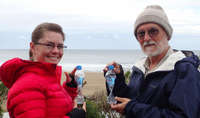
Arthur continued to suffer from a sinus infection for the following
week.
We finally convinced him to take antibiotics and he recovered in a
matter of days.
Kendal suffered from aching,
swollen knees resulting from descending 14,000'
in the last two days of the climb and had bad blisters on her feet.
We both had numb toes resulting from the pounding they took on the
descent;
the numbness went away over the next couple of weeks.
My finger tips felt a little numb for a week.
When we arrived at the coast of the Indian Ocean on the
Wild Coast
of South Africa we unpacked our
“Kilimanjaro Air”
and found the bottles to be a good demonstration of what one has to
cope with at the summit.
The fact we are wearing some of our Kilimanjaro gear is a good indication
that the wind off the Indian Ocean in South Africa can be quite chilly in
July!
Closing Thoughts
We had an excellent support staff.
The combination of guide Renatus as no-nonsense chief organizer and boss
with Nicholas as the avuncular guide worked well.
The other staff appeared to be happy and well-treated,
contrary to what we have heard about some guide services.
The food was excellent throughout the trip.
With the nightly hot water bottles the cooking staff prepared for us the
rented sleeping gear was more than adequate.
We did have problems with zippers on the sleeping tents:
the inner tent zippers did not operate properly and this could have been
a problem if the weather had been more severe.
Getting to the summit of Kilimanjaro was a great feeling and being in a
small private party added to the camaradarie.
But I think for the three of us the most satisfying thing was being able
to achieve a difficult goal as a family team.
We each had problems,
but we overcame them.
Kendal was undoubtedly the most organized
(at least as far as equipment and knowledge of the route)
and persevered through blisters and swollen knees.
Arthur expanded the envelope of his capabilities by fighting through his
sickness to get to the summit.
I managed to continue in spite of digestive issues brought on by lactose
intolerance and convinced myself I could have done high altitude climbs
in my younger days given the time,
money and inclination
(I did have the inclination but no time or money).
Many people say after climbing Kilimanjaro it was
“The most difficult thing I have ever done.”
I have to say it was
not
the most difficult thing I have ever done,
but when I did more difficult things I was much younger and in much
better shape.
Examples of my most difficult climbs are a spur of the moment marathon
climb of
Mount Rainier,
being a mountain guide
for a 9 day high wilderness traverse,
leading the
Index Traverse,
and climbing
Mount Goode.
Back home in Bozeman,
we did not contact the local paper to advertise our summit success.
If one mentions Kilimanjaro at a party here,
there are probably several present who have
“been there, done that.”
If you want to impress a Bozemanite,
climb
Mount Everest.
Being at Altitude
Physically,
we all performed reasonably well in a long trek at altitude,
possible reasons being
(not in any particular order):
-
We all undertook several months of conditioning.
-
We were well acclimatized to the beginning altitudes:
I live at 5,400',
Arthur lives at 4,800',
and Kendal trained at sea level then spent the week before departure
training at over 5,400'.
-
We conditioned with long hikes to over 9,000'
in the weeks prior.
-
We took 7 days rather than 6,
allowing more time to acclimate.
-
In my case:
prior experience with similar summit days,
including
numerous climbs of Mount Rainier.
-
Good genes –
reportedly,
a significant factor in one's ability to acclimate is
determined by genetics.
-
Diamox.
-
Polepole.
-
We took it seriously;
NO PARTYING!
Early to bed and early to rise is essential preparation for summit day.
Take ear plugs if others in your party are rowdy.
Melatonin
or other sleep aids may help,
but be careful of interactions with Diamox
(especially aspirin or other NSAIDs).
-
Research –
we did lots of web research,
including watching an excellent series of videos by
energyrouter.
-
Last
(and certainly not least),
22 support personnel.
Having all those people doing the heavy lifting so you can be well fed
and comfortable helps a lot.
Having the money to hire a good support team is essential.
Even the cut-rate companies may seem expensive,
but one should consider those companies often do not treat their people
well.
If you cannot afford to go with a company that treats their people well,
I would recommend forgoing Kilimanjaro and spending your money
elsewhere.
Do research before selecting a company;
there are many web sites telling you what to look for and recommending
reputable companies.
For example:
Trekking to Everest Base Camp versus Climbing Kilimanjaro
Most accounts on the web agree climbing Kilimanjaro is more difficult
than trekking to Everest Base Camp
(EBC).
Some reasons given are:
-
The EBC elevation is
significantly lower.
In fact,
Kilimanjaro is almost as high as Everest Camp I;
however,
getting to Camp I means traversing the Khumbu Ice Fall and requires
serious mountaineering skill.
-
The trail to EBC is much easier to negotiate
(no Barranco Wall, for example).
-
There are huts and teahouses along the EBC trail;
only one Kilimanjaro route has huts,
and there are no teahouses.
-
The hike to EBC is generally done over a longer time period,
allowing more time for acclimatization.
-
There is no
“killer”
summit day for EBC.
Climbing Mount Rainier versus Kilimanjaro
There are a number of routes up Mount Rainier,
but even the easiest is physically demanding.
People who have climbed both mountains
(including myself)
agree Mount Rainier is in many ways more difficult than climbing
Kilimanjaro because:
-
You must demonstrate competence in glacier climbing and carry the
appropriate equipment,
including:
ropes,
ice axe,
crampons,
mountaineering boots,
and adequate cold weather gear.
-
Guided climbs will include one or more training days.
Private parties must be cleared by park rangers and must include at
least one climber with appropriate experience
(I was qualified enough to be leader or co-leader of 4 climbs).
-
You must carry all your own equipment,
including food and shelter
(this may not be true for some guided climbs).
-
The weather is likely to be more severe,
and typically colder than Kilimanjaro.
-
The objective danger,
and hence casualty rate,
is much higher for Mount Rainier;
see
this
for example.
-
The air at 14,411'
is almost as thin as at 19,341'
—
about 60% versus 50%
of sea level pressure.
-
There is typically less time spent acclimatizing
(especially for local climbers, who usually summit over a weekend).
-
The
“killer”
summit days are very similar,
gaining over 4,000' and descending over 9,000'.





























